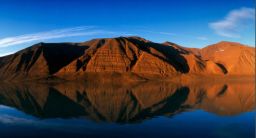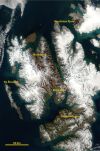Emily Lakdawalla • Aug 31, 2009
Exploring Mars on Earth: The Arctic Mars Analog Svalbard Expedition
High in the Arctic, just below Earth's north polar ice cap, a collaboration of of nearly two dozen biologists, geologists, and engineers comes together every August to practice and prepare for an expedition to Mars. They head to the island of Spitsbergen (part of the Svalbard archipelago), only about 600 miles from the North Pole, in the Arctic Mars Analogue Svalbard Expedition (AMASE).
During AMASE 2006, The Planetary Society co-sponsored the AMASE crew. researchers tested a modified Mark III spacesuit replica. Although the test suit was lighter than the original Mark III, it is still quite heavy on Earth -- about 35 kilograms (75 pounds). Expedition team member Jake Maule, a biologist at the Carnegie Institution of Washington, donned the suit to practice working with science instruments while wearing the cumbersome (although life-preserving) outerwear. You can read Maule's updates here.
During AMASE 2009, the expedition's goals are to integrate and test two new instruments for NASA's Mars Science Laboratory rover and four for ESA's ExoMars rover using the FIDO (Field Integrated Design and Operations) rover from the Jet Propulsion Laboratory as an advanced mobility platform, as well as test protocols for the future Mars Sample Return mission. We're receiving updates from Juan Rodriguez-Blanco, a postdoctoral researcher from the Earth Surface Sciences Institute, University of Leeds, and also from Adrienne Kish. Read Rodriguez-Blanco's updates here, and Kish's updates here.
The Svalbard Analog Site
Svalbard, meaning "cold coast," is an archipelago composed of four main islands and about 150 smaller ones. It's a Norwegian territory located about halfway between Tromso in Norway and the North Pole. Roughly 60 percent of Svalbard is glacierized.
One of this year's expedition sites, located in the Bockfjorden area of Svalbard at 80ºN, is an intriguing place where hot meets cold. About 1 million years ago, the Sverrefjell volcano erupted through an ice sheet. Today, the ice sheet is gone, and the volcano is quiet. In this dry and cold environment, hot springs still simmer, exhaling Argon and Helium gasses from Earth's mantle. Shaped by volcanism, ice, and liquid water, Svalbard reminds us of how Mars might have once been. Volcanic activity like this could still percolate beneath the surface of Mars and may be a potential habitat for microbial life.
The AMASE site has another important connection to Mars. Here, scientists have found carbonate spherules that are nearly identical to those we see in Martian meteorite ALH84001 -- the meteorite discovered in 1996, which, although still controversial, houses possible evidence of simple life. The spherules found in Bockfjorden typically have iron-rich cores and magnesium-rich rims, sometimes embedded in a calcite matrix -- a texture and composition that is identical to ALH84001. Expedition scientists are looking at both abiological and biological agents that may produce the Earthly carbonate spherules to better understand what may have formed similar structures on Mars.
The expedition team traveled to the Bockfjorden area by boat, and returned to that boat to sleep each "night" (in August, there is 24 hours of daylight). Camping in this area of Svalbard is very dangerous due to polar bears.
Support our core enterprises
Your support powers our mission to explore worlds, find life, and defend Earth. You make all the difference when you make a gift. Give today!
Donate

 Explore Worlds
Explore Worlds Find Life
Find Life Defend Earth
Defend Earth



